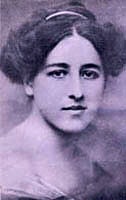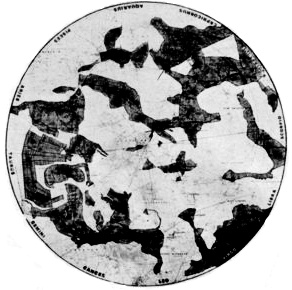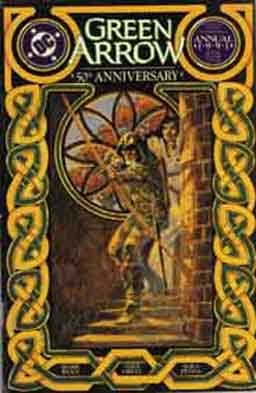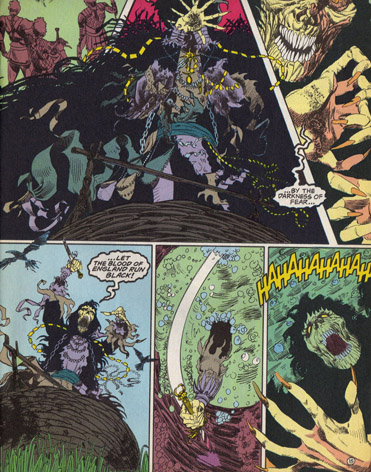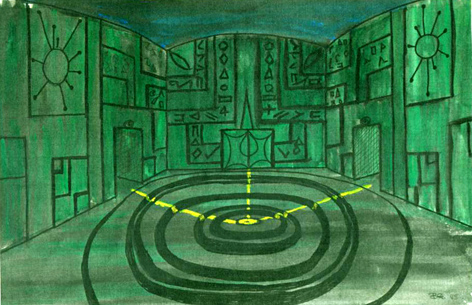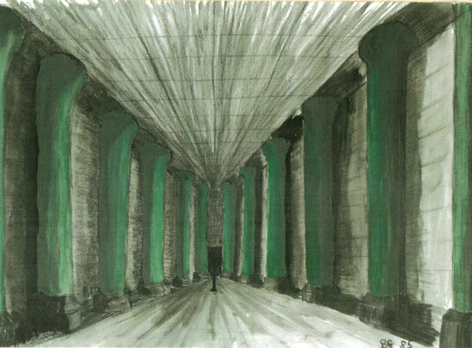![]()
![]()
Bernard,
the star of The Black Alchemist and
other books dies this week at the age of
seventy.

Bernard beneath a tree in Danbury churchyard
It is with great sadness that I report the death of my long time colleague and friend Bernard, known to many of you through my various psychic questing books. He died during the early hours of Tuesday, March 30th, having been ill since suffering a brain haemorrhage two years ago.
Bernard features in my books as a psychic of unequalled ability, picking up on everything from the nefarious activities of the Black Alchemist to the search for the Egyptian Hall of Records, somewhere we have always referred to as the Crystal Chambers. From the publication of The Black Alchemist in 1988 through to the present day, I have respected Bernard's wish to withhold his surname and background, and this is something I shall adhere to here.
I first met Bernard in March 1983 following correspondence regarding the medieval mysteries surrounding the village of Danbury in Essex. We had come here to visit the parish church of St John-the-Baptist which contained three wooden knight effigies in its aisles. They belonged to members of the St Clere family, who controlled the manor of Danbury during the thirteenth century. This was the same St Clere (or St Clair) family featured in the mystery of Rennes-le-Chateau and the Priory of Sion, popularised by broadcaster Henry Lincoln in three Chronicle programmes during the 1970s, and featured afterwards in the bestselling book The Holy Blood and the Holy Grail, co-written with Richard Leigh and Michael Baigent (Jonathan Cape, 1982).
The site chosen by the St Cleres for Danbury's church of St John the Baptist was within the ramparts of an Iron Age hillfort located upon a prominent hill, making its spire visible for miles around. Here, just behind the churchyard, a beacon fire has always burned, and the fact that the church's dedication honours John-the-Baptist, whose feast day coincides with midsummer's day, when beacon fires were lit throughout the land, hinted to Bernard and I that there was some inner mystery surrounding with the location. This conclusion seemed confirmed by the fact that local members of the St Clere family used a heraldic device showing a blazing sun on a sky blue background. It was a subject explored in a book I wrote, with Bernard's cooperation, entitled The Knights of Danbury, published in 1984.
The Knights of Danbury is a local history book, respected even today by the local community. Yet its final chapter features a fascinating dream experienced by Bernard during our research. It describes the funeral of one of the thirteenth-century St Clere knights buried in the church. So vivid was this dream that it allowed us to identify not only the knight being buried, but also the names of the other two knights interred beneath wooden effigies in the church.
It was with this dream that I realised something important about Bernard. He was what I referred to as a direct information psychic - someone who has the ability to pick up information containing names, dates and places on a regular basis. I had worked with a few such people before, but the accuracy of Bernard's ability intrigued me from the outset. What is more, Bernard and I shared not only similar interests, but also a passion to uncover the mysteries of the past. We also liked a drink, and a smoke. After meeting at the church, or on the green in front of it, we would always retire over the road to The Griffin pub, where over a pint or two we would discuss our latest research and talk about his latest dreams or visions.
Working with Bernard's psychic talent, we began targeting specific subjects of interest. We looked initially at the history of the St Clere family, a topic that would trigger Bernard's own interest in medieval heraldry. To started a project to paint the heraldic devices of every single member of the Order of the Garter from its inception in the fourteenth century through to the modern day. How far he actually got in this project I do not know, but it was something that engaged him for many years to come.
Glastonbury
Zodiac Quest
By the summer of 1984 our psychic work into the background of the St Clere family had dovetailed into some quite separate research I was carrying out into the reality of the so-called Glastonbury zodiac. This is a perceived twelve-mile circle of topographic features, including hills, roadways, streams and fields, that with the presence of unusual place-names and local folklore, had suggested to the artist and sculptress Katherine Maltwood that present within the local landscape around Glastonbury was a terrestrial zodiac of prehistoric design.
I never believed in the Glastonbury zodiac, until one day, during meditation, I was unexpectedly carried in mind to a place named Kingweston, which I felt was in Somerset. Here I felt a connection with a heraldic lion. Only afterwards did I realize that Kingweston formed part of the landscape effigy representing the astronomical sign of Leo in the Glastonbury zodiac, a very strange coincidence. I was even more intrigued to read that Leo was the first landscape effigy recognised by Katherine Maltwood; the image of the lion having quite literally leapt out of the map at her. She had pondered over what it might represent, before noticing a second effigy ay nearby Dundon, which she identified as an astrological representation of Gemini. Soon afterwards she began constructing the entire zodiac.
Maltwood believed that the Glastonbury zodiac reflected the heavens as they might have been seen, mirror fashion, some 4,700 years ago, when the star Kochab in Ursa Minor was Pole Star. This led to her somewhat tangential conclusion that the zodiac had been sculpted by Sumerian astronomer priests, who came to settle on the Somerset levels during this distant epoch. She also came to believe that the zodiac and its hidden symbolism was the true origin behind the development of the Grail legend, in particular the version offered by an early thirteenth century work entitled Perlesvaus, published in Victorian times under the more popular title of The High History of the Grail.
In the knowledge that the writer of Perlesvaus was most likely a monk from Glastonbury abbey, Maltwood concluded that the highly symbolic imagery it preserved contained the key to unlocking the mysteries of the Glastonbury zodiac, which she felt concealed the ultimate secrets of the Grail. Clues were to be found in local place-names and folklore, as well as in the astrological influences resonating within each of the twelve landscape effigies.
Katherine Maltwood |
Maltwood's conception of the Glastonbury zodiac |
Despite the lack of hard evidence to support Maltwood's contentions about the Glastonbury zodiac, I realised that if it existed at all, then its had to act as a kind of psychic assault course, approached through dreams, visions and personal experiences. Each sign, I felt, had to be approached and navigated in a particular fashion and order, starting with the Leo figure, which I concluded was the point of entry into the zodiac. I began my zodiac quest in 1983, but had faltered after traversing just three signs - Leo, Gemini and Virgo, in that order.
Then in 1984, Bernard, without knowing of my interest in the Glastonbury zodiac, started picking up on this very same subject, after I had mentioned to him that I had discovered that a branch of the St Clere family had owned a manor in Somerton, just outside of Glastonbury. Even more intriguing was the fact that they had used the same blazing sun device employed by their contemporaries in Essex. A little detective work revealed that one of the knights buried at Danbury, one Robert de St Clere, also owned the manor at Somerton. This intrigued Bernard and I, although what happened next was unexpected. He began picking up on the Glastonbury zodiac, suggesting that Robert de St Clere had himself attempted to discover it secrets - a vision quest that had ultimately failed.
Bernard went so far as to suggest that I was Robert de St Clere in a past life and that it was my destiny to rejoin the quest and achieve what Robert had failed to do - learn the secret of the Grail.
Without giving the game away, I asked Bernard where we might begin this quest, to which he picked up the heraldic symbol of the lion, indicating the figure of Leo. This made sense, not only from my own quest so far, but also in the fact that Somerton, the seat of the St Cleres in Somerset, was located in Leo. Here, it would seem, Robert de St Clere had begun his own quest to navigate the Glastonbury zodiac.
In September 1984, Bernard accompanied me as we traversed the first five signs of the Glastonbury zodiac - these being Leo, Gemini, Virgo, Scorpio (where we encountered a spectral black knight), and, finally, Sagittarius. The entire vision quest heavily featured Bernard's psychic inspiration, in the form of dreams, waking visions and intuitive insights. For us there was no doubt - the Glastonbury zodiac was real. It existed as a subtle energy matrix, created through human interaction across what appeared to be many thousands of years, with the strongest imagery picked up coming from the time of Robert de St Clere, when the Perlesvaus would have been available to those who sought it.
Bernard's
First Artefact
It was whilst traversing the Virgo figure, at a round barrow named Wimble Tump, that Bernard achieved his first psychically retrieved artefact. He saw a cross being held in the hands of a female spirit standing on the mound, and was told we needed this to continue the quest. I said we could make one, but he emphasized that we needed the one she held. Realizing that this artefact might be concealed somewhere at the site, I told him to attune very carefully to the mound, which we had not yet climbed. He did so and was led to search in the lose soil at the roots of a large tree. Here, without too much effort, he came across a high quality happy death cross in ebony and silver, like the ones worn around the waist by monks and nun. How it got there was never made clear, but its discovery left Bernard on his knees in tears. It was an incredible sight, and a remarkable moment in my life. Bernard would go on to retrieve many more objects by psychic means, either placed in modern times or still in situ after thousands of years, but none were as sweet as the discovery of this cross.
Following our completion of the first half of the Glastonbury zodiac, Bernard informed me that he had been diagnosed with high blood pressure, something he felt was being exacerbated by the intense psychic work. He asked to be excused from any future quests, something I had to accept. Despite this conscious withdrawal from the scene, we still met regularly in The Griffin at Danbury, discussing his latest dreams and visions, which did in no way abate. Little did either of us realise that looming on the horizon was a quest that might well have resulted in far worse than Bernard's high blood pressure. Indeed, it could easily have led to our deaths.
The
Black Alchemist
In April 1985 Bernard visited the tomb of Sir Robert Fitzhamon, one of the great ancestors of the St Cleres of England. It lay in a private chapel inside Tewkesbury Abbey in Gloucestershire, and having gained access to this sepulchre he placed his hand on the cold stone and awaited some kind of response. Bernard very quickly found himself in conversation with this long dead knight, who seemed to want to tell him about a gold treasure, a staff known as the Stave of Nizar, that had apparently been stolen from his place of rest soon after his interment. According to the spirit of Fitzhamon, it had been translated to the south of England, where it had come under the guardianship of the monks of an abbey at a place called Wilmington in East Sussex. Nearby was the tiny church of Lullington, where the monks had apparently brought the stave on occasions, and it was here that Bernard and I ended up on 24th May 1985, searching for further clues as to the current whereabouts of this priceless artefact.
Yet whilst in Lullington churchyard, something unanticipated occurred. Bernard began feeling that some kind of "black magic" had recently gone on here. The energy associated with this ritual activity was giving him a headache, leaving him unable to continue the quest to find Fitzhamon's treasure. Eventually, Bernard was drawn towards a clump of old foundations where he searched and recovered a length of shale shaped like a spearhead. The object was covered in strange hieroglyphs, which I later identified as the so-called Formula of the Crab, created by a fourth-century Egyptian alchemist named Zosimos of Panopolis.

Bernard
in Lullington churchyard in East Sussex, holding the length of shale covered in
hieroglyphics later identified as the Formula of the Crab. Finding this fixing
marker began the saga of the Black Alchemist.
As a result of finding the stone spearhead, Bernard received glimpses of the person responsible for depositing this artefact - a nefarious occultist whom we came to refer to as the Black Alchemist. He would become immortalised not just in a book of the same name, but also, eventually, by virtue of the success of the book, published in 1988, as a major villain in DC Comic's "Green Lantern" and as a bad guy in a Lara Croft "Tomb Raider" computer game.
50th anniversary special edition of the Green Arrow DC comic, co-written with actor Mark Ryan, the character "Nizar" in the 1980s TV series "Robin of Sherwood". |
The Black Alchemist graphically portrayed in a special edition of the Green Arrow DC comic |
Death threats, and psychic attack on an unimaginable scale resulted from our connection with the activities of the Black Alchemist, all just as southern Britain was hit by the first hurricane in nearly 200 years. This kept up busy for nearly three years, but during this period of intense darkness, other remarkable activities were occurring on a questing front.
The Black Alchemist as portrayed in a Lora Croft computer game.
The
Crystal Chambers
With Bernard's help and support, I completed the Glastonbury zodiac quest in June 1985. Over a period of 72 hours I traversed the remaining signs, now on my own, conducting meditations, experiencing strange things, and getting ever nearer to its final secrets, which I came to realize lay at a location that marked the suspected centre of the terrestrial zodiac. This turned out to be an apple orchard just outside the village of Butleigh, just a few miles from the church of Kingweston, where our quest had begun the previous year. What I experienced in the centre of the zodiac is virtually beyond words. All I can say is that it changed the way I perceived reality forever. It is a story I will tell in full someday.
It was around this same time that Bernard's greatest legacy to the new age movement began to emerge, and it was one that was not unconnected with the achievements of the Glastonbury zodiac quest. This was his description of what became known as the Crystal Chambers, a matrix of chambers and passageways that he believed awaited discovery beneath the Pyramids of Giza. It was a structure that he felt had been constructed by a group of extremely tall individuals with white hair and albino-like features known as the Elders who thrived even before the end of the last Ice Age, c. 11,000-10,000 BC.
Such visions were not new. In the 1920s psychics such as Edgar Cayce and H C Randall Stevens had spoken of a Hall of Records of Chamber of Initiation accessed via an entrance in the vicinity of the Sphinx monument. However, what Bernard was remotely viewing seemed infinitely more vivid - a series of twelve chambers surrounding a thirteenth one containing a huge, multi-faceted crystal, representing the moment of first creation in the universe, as well as the zodiac's central or polar axis. During this distant epoch, when the Crystal Chambers were still accessible, Giza was still a verdant green landscape. An island in a lake fed by the Nile marked the position of the central crystal and represented the first land to emerge from the primeval waters of chaos at the beginning of time.
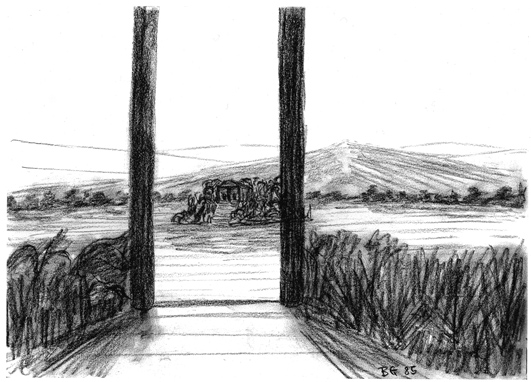
Bernard's
vision of the island of creation in a lake fed by the Nile as it might have appeared
in c. 11,000 BC. The building on the island marks the entrance to the Crystal
Chambers.
In an attempt to explore Bernard's vision of the Crystal Chambers more fully, I hired a derelict meeting hall in the middle of a council estate at a place called Malyons in Basildon, Essex, and on two separate nights towards the end of 1985 we converted the place into a pseudo Egyptian temple and, as children outside kicked balls against the boarded windows, attempted to focus our attentions on penetrating this underground complex using remote viewing, astral projection and far memory.
What occurred during those Crystal Chambers sessions in Malyons Meeting Hall (long since demolished) changed my entire outlook on life, and led me on a 23-year quest to find the entrance to Giza's cave underworld - something I would ultimately achieve in March 2008. The story behind this discovery is told in my book Beneath the Pyramids, dedicated to Bernard. Clearly, what we have found at Giza can in no way be classed as the Crystal Chambers, but the more we discover about the cave complex, the more it seems to resonate with what Bernard said awaiting discovery down there.
The full story of the Crystal Chambers will be given in a separate book coming soon.
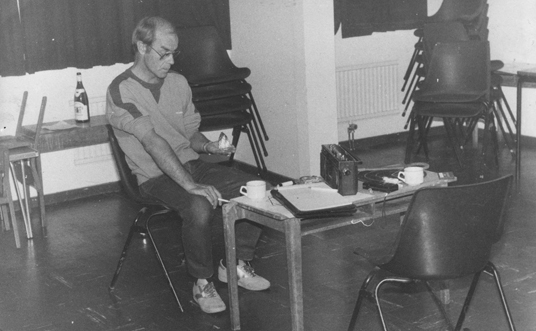
Bernard picks up further information about the Crystal Chambers inside Malyons Meeting Hall in Basildon, Essex. The whole place had been converted into a temporary Egyptian temple.
From 1989 I began working with other direct information psychics, and developed my own questing posse, derived from members of Earthquest, a group that met regularly in Leigh-on-Sea, Essex. Still I would meet Bernard at The Griffin in Danbury for a drink and catch up, and occasionally I would take friends to meet him. Never did they fail to go away utterly flabbergasted by his incredible personality and insights, which often came as cryptic personal messages to be understood by them alone.
Bernard saw my world as evolving into a commercial and spiritual success, as my books sold more and more and public events put on by me, such as the annual Questing Conference, continued to grow in popularity. I could now stand up on my own two feet, and even psychic quest myself, and with these changing circumstances I began to see less and less of him until he was no more than a voice at the end of a telephone.
Bernard's painting from 1985 of the first of the twelve chambers in a double hexagram pattern surrounding a thirteenth, central chamber that supposedly contained a large multi-faceted crystal, symbolising the polar axis and act of first creation in the universe. The walls of the twelve outer chambers were said to be fashioned from a green carved stone. The double doorway seen in the centre led to the central chamber - the doorways on the left and right to other chambers. Note the symbol of the egg of creation beneath the conical obelisk design. |
According to Bernard, before reaching the Crystal Chambers the twelve Elders would first have to navigate an extremely long passageway in which were various structures, doors and obstacles, including the Hall of the Twelve depicted here by Bernard in 1985. Each of the twelve pillars was hollow, and resonated a different vibrational resonance when tapped. |
I recall being in Egypt in 1998 conducting a ritual meditation in a hotel room in Giza hoping to achieve further insights into Giza's cave underworld. I asked him to attune at the same time from his home in Essex to see what, if anything, he might pick up.
I then lost touch with him for some while, seeing him only once in ten years at the funeral of my father in 2002. Then in February 2008 I felt an urge to speak with him again, and on ringing his number I discovered that he had just returned from hospital following an emergency operation following a sudden brain haemorrhage. Days later I was out in Egypt again, coordinating a mass healing session in his honour. Friends across Britain, and even a new age group we met in the hotel at Giza, all came together to send Bernard healing energies. A day later we discovered the entrance to Giza's cave underworld.
Bernard recovered from his illness very slowly, and we spoke whenever I had the courage to pick up the phone and dial his number. It was in the wake of the discovery of the caves at Giza that Bernard picked up his last known piece of psychic information. Telling him about the caves, he began seeing a large bird, a bird of prey, with its wings lowered, as if protecting something. He saw this image in connection with the caves, and felt there was a link somehow. It made sense, as a kite or hawk is often shown hovering over the mummified body of the deceased in ancient Egyptian tradition. It was a meagre piece of information, but poignant, not only because the tomb through which access is gained into the caves was once used as a cemetery for the interment of bird mummies, but also in the fact that for the ancient Egyptians the soul or spirit in death was represented by a bird.
I spoke to Bernard when I could after that, but somehow I knew that we would never meet again. I dedicated Beneath the Pyramids to him, and made sure that he received a copy on publication. I wanted him to see that his inspired insights had been paramount in the rediscovery of Giza's cave underworld.
It was with immense sadness that I learned that he had died in his sleep at 01:30 on Tuesday, 30th March, 2010, after doctors could do no more for him. He was seventy years of age, and leaves behind a wife, daughter and grand children.
The Black Alchemist cover | There
is no doubt that Bernard was one of the most influential people in my life. Without
him I might never have become a successful author, since it was The Black Alchemist,
a book inspired by his psychic work, that first got me noticed by major publishers. Sometimes I wish that he had been more active as a psychic. We could have worked together to solve whatever mystery we wanted, his ability being as accurate as any psychic I have ever come across (over 90 percent accurate on occasions). Yet I have to respect that whereas I might see the use of such powers as great fun, to direct information psychics like him they are often a burden, creating an intense pressure that can indeed make them ill. |
I
just have to be humble at what our long term friendship did give me, and this
was an expanded perspective of reality, and a trust in the powers of the mind.
Yet Bernard was much more than this - he was a great person, a wise teacher and
a modern day sage and shaman, albeit one that perpetually wanted to disown his
own abilities. And I haven't even got on to any of the other great quests we shared
or, indeed, those he experienced when on holiday in foreign parts. It is also
important to mention that he was an earth mysteries researcher, and in the early
1980s took part in the Dragon Project, coordinated by Paul Devereux, then editor
of The Ley Hunter magazine. He was also widely respected as a genealogist
and researcher of medieval heraldry, an interest generated in the wake of his
dedicated research into the St Clere family.
I would describe Bernard as a modern-day Merlin the magician, although one without the long hair, beard and pointy hat. If you've ever seen the John Boorman's film "Excalibur", released in 1981, then the manner in which Merlin is portrayed by British actor Nicol Williamson adequately reflects Bernard's personality and overall attitude to life.
He tutored me well, and now hopefully he has ascended to the heavenly realms where he will continue to educate the novice on the earthly planes.
To read more about Bernard, see my books:
Knights
of Danbury (1984)
The Black Alchemist (1988)
The Seventh Sword
(1991)
The Second Coming (1993)
The Circlemakers (1992)
The
New Circlemakers (2008)
The 2010 Psychic Questing Weekender, which will heavily feature the story and magic of the Black Alchemist, will be dedicated to Bernard's memory. I shall review his psychic work and legacy to the world. For more information and tickets, click here.
![]()
![]()
